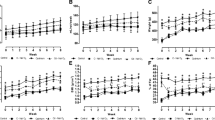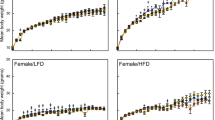Abstract
The effects of chronic cadmium exposure on adipose tissue have not been extensively reported. In adult Wistar male rats we investigated in vivo effect of 6 weeks lasting cadmium intake in drinking tap water (CdCl2 9,7 mg/l). Insulin receptors in isolated adipocytes from epididymal fat and glucose transporter protein GLUT4 content in fat tissue plasma membranes were determined. Control and Cd treated rats had similar water intake with subsequent heavy augmentation of Cd content in liver of experimental animals. In comparison with controls, Cd intake did not influence body mass increment and fat cell size, but significantly increased serum glycemia and moderately elevated insulinemia. Cadmium intake significantly reduced (∼ 50%) both, total insulin receptors number and density of the receptors in fat cells. No differences in the content of GLUT4 in crude plasma membranes of adipose tissue were observed. Diminished insulin receptors in adipocytes could account for diabetogenic effect of long lasting cadmium intake.
Similar content being viewed by others
References
Belzung F, Raclot T, Groscolas R. 1993 Fish oil n-3 fatty acids selectively limit hypertrophy of abdominal fat deposits in growing rats fed high-fat diet. Am J Physiol 264, R1111–R1118.
Beyersmann D, Hechtenberg S. 1997 Cadmium, gene regulation, and cellular signalling in mammalian cells. Toxicol Appl Pharmacol 144, 247–261.
Chapatwala KD, Hobson M, Desaiah D, Rajanna B. 1982 Effect of cadmium on hepatic and renal gluconeogenic enzymes in female rats. Toxicol Lett 12, 27–34.
Endo T, Kimura O, Sakata M. 1999 Further analysis of cadmium uptake from apical membrane of LLC-PK1 cells via inorganic anion exchanger. Pharmacol Toxicol 84, 187–192.
Ezaki O. 1989 IIb group metal ions (Zn2+, Cd2+, Hg2+) stimulate glucose transport activity by post-insulin receptor kinase mechanism in rat adipocytes. J Biol Chem 264, 16118–16122.
Ghafghazi T, Sheriat HS, Dastmalchi T, Barnett RC. 1977 Antagonism of cadmium and alloxan-induced hyperglycemia in rats by Trigonella foenum graecum. Pahlavi Med J 8, 14–25.
Golda V, Ficková M, Pinterová L, Jur?ovi?ová J, Macho L, Zórad S. 2001 Terguride attenuates prolactin levels and ameliorates insulin sensitivity and insulin binding in obese spontaneously hypertensive rats. Physiol Res 50, 175–182.
Harrison SA, Buxton JM, Clancy BM, Czech MP. 1991 Evidence that erythroid-type glucose transporter intrinsic activity is modulated by cadmium treatment of mouse 3T3-L1 cells. J Biol Chem 266, 19438–19449.
International Agency for Reasearch on Cancer Monographs 1993 Cadmium, vol. 58. Lyon: IARC Press; 119–238.
Kasuga M, Akanuma Y, Iwamoto Y, Kosaga K. 1977 Effects of fasting and refeeding on insulin receptors and glucose metabolism in rat adipocytes. Endocrinology 100, 1384–1390.
Kelley C. 1999 Cadmium therapeutic agents. Curr Pharm Des 5, 229–240.
Kielan Z, Ziolkowska B, Falkus B, Jethon Z. 1989 Effect of cadmium intoxication on glucose utilization in energy metabolism of muscles. Acta Physiol Pol 40, 535–543.
Korzun EA, Heck HH. 1990 Sources and fates of lead and cadmium in municipal solid waste. J Air Waste Manage Assoc 40, 1220–1226.
Merali Z, Singhal RL. 1980 Diabetogenic effects of chronic oral cadmium administration to neonatal rats. Br J Pharmacol 69, 151–157.
Munson PJ, Rodbard D. 1980 Ligand: A versatile computerized approach for characterization of ligand-binding systems. Anal Biochem 107, 220–239.
Mussalo-Rauhamaa H, Leppanen A, Salmela SS, Pyysalo H. 1986 Cigarettes as a source of trace and heavy metals and pesticides in man. Arch Environ Health 41, 49–55.
Nakamura K, Nishiyama S, Takata T, Suzuki E, Sugiura Y, Kobayashi T, Chao BY. 1983 Effects of zinc on cadmiuminduced alterations in hepatic functions and blood glucose of rats. Environ Res 30, 175–181.
Nilsson T, Rorsman F, Berggren PO, Hellman B. 1986 Accumulation of cadmium in pancreatic beta cells is similar to that of calcium in being stimulated by both glucose and high potassium. Biochim Biophys Acta 888, 270–277.
Nilsson T, Berggren PO, Hellman B. 1987 Cadmium-induced insulin release does not involve changes in intracellular handling of calcium. Biochim Biophys Acta 929, 81–87.
Rodbell M. 1964 Metabolism of isolated fat cells. Effects of hormones on glucose metabolism and lipolysis. J Biol Chem 239, 375–380.
Scatchard G. 1949 The attraction of proteins for small molecules and ions. Ann NY Acad Sci USA 51, 660–672.
Schwartz GG, Reis IM. 2000 Is cadmium a cause of human pancreatic cancer? Cancer Epidemiol Biomark Prev 9, 139–145.
Smith CJ, Livingston SD, Doolittle DJ. 1997 An international literature survey of ‘IARC Group I carcinogenes’ reported in mainstream cigarette smoke. Food Chem Toxicol 35, 1107–1130.
Verougstraete V, Lison D, Hotz P. 2002 A systematic review of cytogenetic studies conducted in human populations exposed to cadmium compounds. Mutat Res 511, 15–43.
Waalkes MP. 2000 Cadmium carcinogenesis in review. J Inorg Biochem 79, 241–244.
Waalkes MP, Coogan TP, Barter RA. 1992 Toxicological principles of metal carcinogenesis with special emphasis on cadmium. Crit Rev Toxicol 22, 175–201.
Watanabe M, Suzuki T. 2002 Involvement of reactive oxygen stress in cadmium-induced cellular damage in Euglena gracilis. Comp Biochem Physiol C Toxicol Pharmacol 131, 491–500.
Whitehead JP, Molero JC, Clark S, Martin S, Meneilly G, James DE. 2001 The role of Ca2+ in insulin-stimulated glucose transport in 3T3-L1 cells. J Biol Chem 276, 27816–27824.
Yamamoto A, Wada O, Ono T, Ono H, Manabe S, Ishikawa S. 1984 Cadmium-induced stimulation of lipogenesis from glucose in rat adipocytes. Biochem J 219, 979–984.
Yamamoto A, Wada O, Ono T, Ono H. 1986 Cadmium stimulates glucose metabolism in rat adipocytes. J Inorg Biochem 27, 221–226.
Zorad S, Svabova E, Klimes I, Macho L. 1985 Comparison of radiochemical purity and tissue binding of labelled insulin prepared by lactoperoxidase and chloramine T iodination. Endocrinol Exp 10, 267–275.
Author information
Authors and Affiliations
Rights and permissions
About this article
Cite this article
Ficková, M., Eybl, V., Kotyzová, D. et al. Long lasting cadmium intake is associated with reduction of insulin receptors in rat adipocytes. Biometals 16, 561–566 (2003). https://doi.org/10.1023/A:1023485130767
Issue Date:
DOI: https://doi.org/10.1023/A:1023485130767




